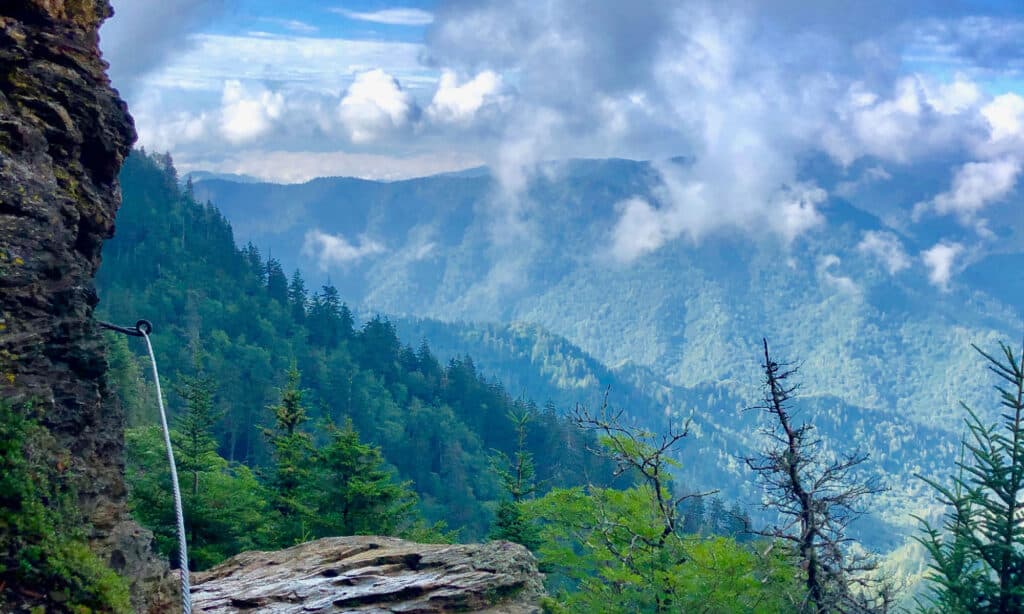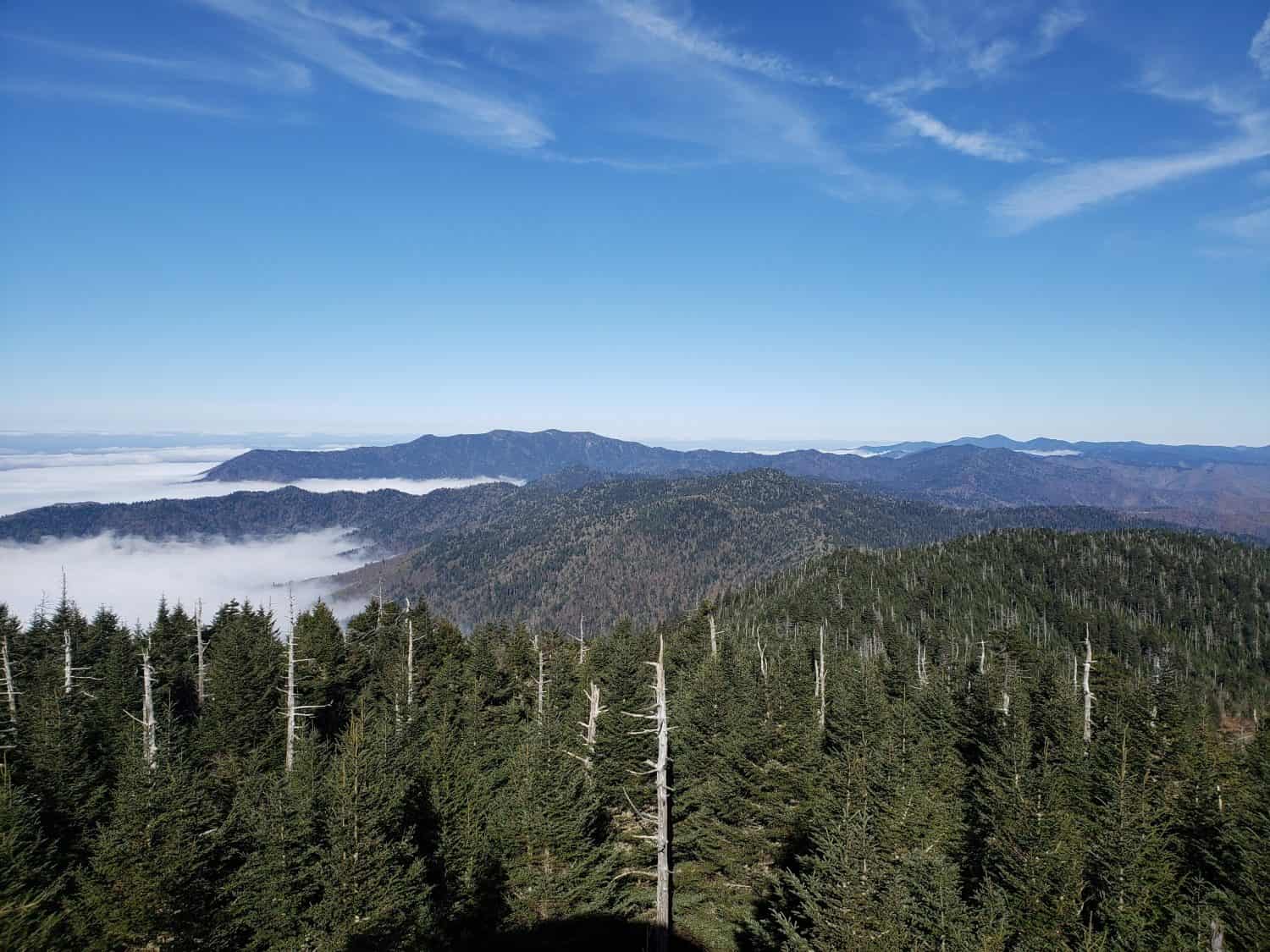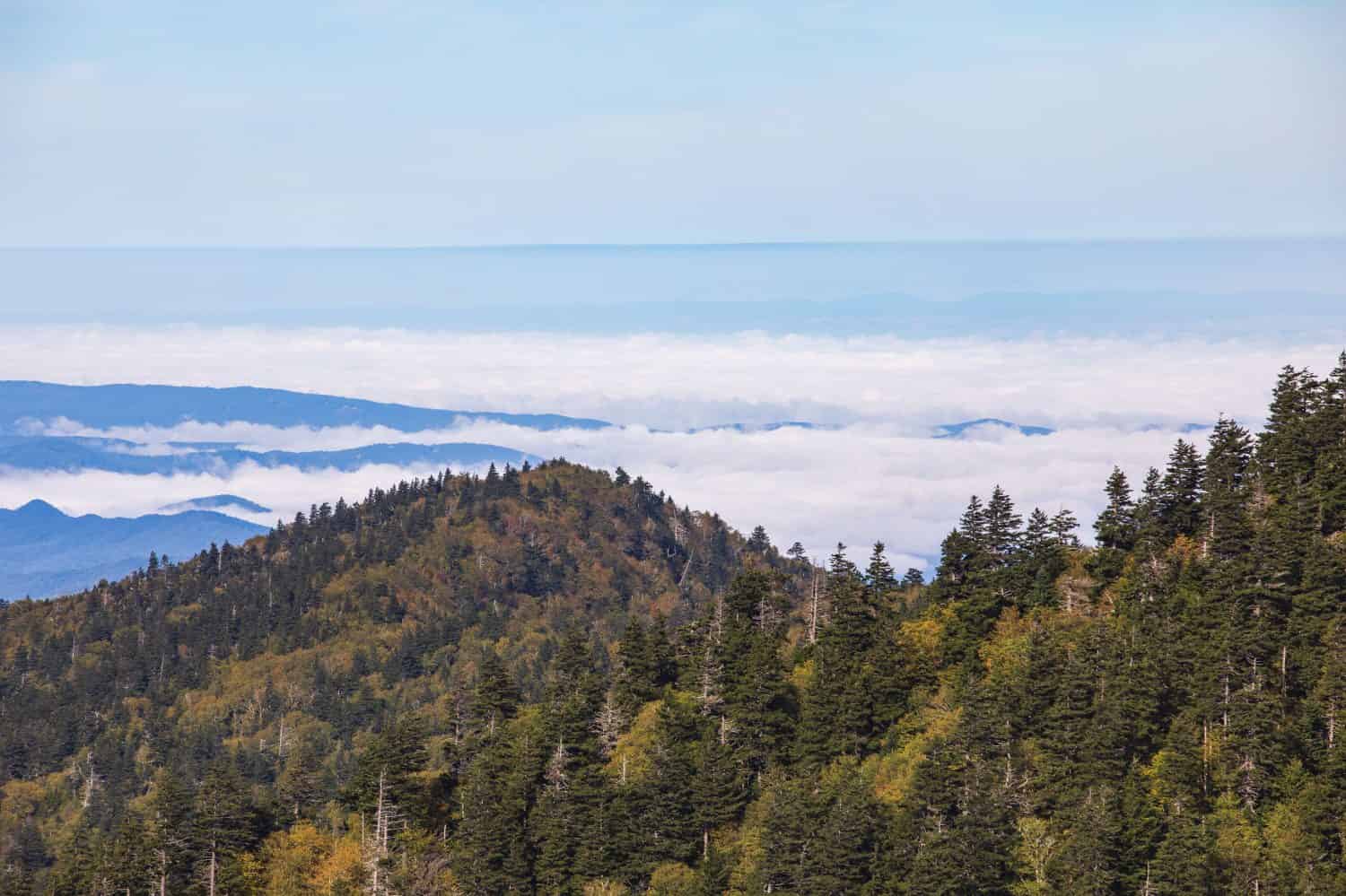Mount LeConte is one of the most popular hiking destinations in the Smoky Mountains. The hiking trails to the top are strenuous. However, they’re worth the challenge to enjoy the panoramic view of the peaks, cliffs, and sprawling forest below. But just how tall is Tennessee’s Mount LeConte? Keep reading to find out how far into the sky the famous peak takes you.
How Tall Is Tennessee’s Mount LeConte?

Tennessee’s Mount LeConte is 6,593 feet, making it the third-highest peak in the Great Smoky Mountains National Park.
©Sara Parlier/Shutterstock.com
So, how tall is Tennessee’s Mount LeConte? At 6,593 feet, Mount LeConte is part of the Appalachian Mountains and is the third-highest peak in the Great Smoky Mountains National Park. It’s also the only Tennessee summit wholly in the state. You can find the impressive summit south of Gatlinburg.
Moreover, the nearby LeConte Lodge is the highest guest lodge in the eastern U.S. Originally a tent camp set up by Paul Adams in 1925, the rustic retreat provides a majestic view of the range. It’s located below the summit at an elevation of 6,400 feet. If you want to stay here, you have to hike one of the five hiking trails leading to its door. The trails are between 5 and 9 miles, depending on where your trek begins. There are no roads to the Lodge.
History of Tennessee’s Mount LeConte

Mount LeConte’s namesake is a mystery.
©Alisha Bube/Shutterstock.com
Tennessee’s Mount LeConte is made of sandstone, siltstone, shale, and other Late Proterozoic rocks that formed 800 to 450 million years ago. You can find the summit in the center of the Great Smoky Mountains National Park, surrounded by a collection of lower peaks and the highest peak in Tennessee.
However, it’s unclear which member of the LeConte family the summit is named after. Records show conflicting evidence that the peak’s name honors Joseph or his older brother, John.
Some sources, including the United States Geological Survey, list famous geologist and former professor at the University of California, Berkeley, Joseph Le Conte, as its namesake. Due to his work on the mountain, this would make the most sense. But, the authors of “A Natural History of Mount LeConte” suggest it was named after John.
John LeConte was a scholar and served as president of the University of California in the late 1800s. According to the aforementioned book, naturalist Sam Buckley named the summit after John despite his lack of popularity compared to Joseph because he previously helped him with a big favor.
Mount LeConte was measured in the mid-19th century but remained relatively unexplored. Then, a man named Paul Adams became a Great Smoky Mountain Conservation Association member in the 1920s. To accomplish the group’s mission of making the area a national park, he started a grand expedition that involved hiking the mountain nearly 500 times throughout his life. He captured his experiences in his books Mt. LeConte and Cumberland Jack, which features his legendary dog accompanying him on his treks.
As a result of his effort, Paul Adams and the Great Smoky Mountain Conservation Association established Mount LeConte in 1925.
How Does Mount LeConte Compare to Other Peaks?

Clingmans Dome is close to Mount LeConte.
©Will Beach/Shutterstock.com
Several other mountains surround Mount LeConte. For example, it’s close to Clingmans Dome, the highest peak in the Great Smoky Mountain National Park, and the state overall. However, many famous summits in the park are also part of the Southern Sixers Club. Below you will see how Tennessee’s Mount LeConte compares to other behemoths in the state and around the country.
Mountains in Tennessee
| Summit Name | Location | Height |
|---|---|---|
| Clingmans Dome | Great Smoky Mountains National Park | 6,643 feet |
| Mount Guyot | Great Smoky Mountains National Park | 6,621 feet |
| Mount Chapman | Great Smoky Mountains National Park | 6,417 feet |
| Old Black | Great Smoky Mountains National Park | 6,370 feet |
| Thunderhead Mountain | Great Smoky Mountains National Park | 5,527 feet |
Mount LeConte’s Major Peaks
| Peak Name | Height |
|---|---|
| High Top | 6,593 feet |
| Cliff Tops | 6,555 feet |
| Myrtle Point | 6,443 feet |
| West Point | 6,344 feet |
Cliff Tops and Myrtle Point give hikers an incredible 360-degree view of their section of the Smoky Mountains and beyond. On the other hand, the dense forest of the remaining peaks obscures the view. Furthermore, hikers can find the spring atop the mountain that provides water for LeConte Lodge. Balsam Point is a 5,820-foot-all peak farther west of Tennessee’s Mount LeConte.
Mountains Throughout the U.S.
| Summit Name | State | Height |
|---|---|---|
| Denali | Alaska | 20,310 feet |
| Mount Whitney | California | 14,494 feet |
| Mount Elbert | Colorado | 14,433 feet |
| Mount Rainier | Washington | 14,411 feet |
| Gannett Peak | Wyoming | 13,804 feet |
Wildlife Around Tennessee’s Mount LeConte

Look for peregrine falcons on the top of Mount LeConte.
©Harry Collins Photography/Shutterstock.com
The Great Smoky Mountains National Park has one of the largest expanses of wildlife in the east. The park is home to over 200 varieties of birds, 65 species of mammals, 67 native fish species, and nearly 80 different reptiles and amphibians.
Tennessee’s Mount LeConte is the perfect birdwatching spot. You can see peregrine falcons soaring through the open sky as they bring food back to their nests. Depending on the season, you can hear the call of their eyasses (chicks). If you stand at the top of the summit and look at the sky for a while you may also see a bald eagle, cross-billed finch, or a black-throated blue warbler.
In addition to the many birds, hikers on Mount LeConte can come across black bears, wild turkeys, deer, northern flying squirrels, and rock voles. The Great Smoky Mountains National Park is also known as the “Salamander Capital of the World,” so expect to see their slim bodies darting through the soil or up a tree.
Thank you for reading! Have some feedback for us? Contact the AZ Animals editorial team.








